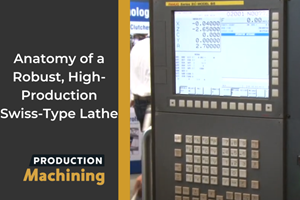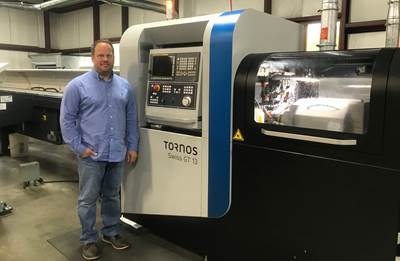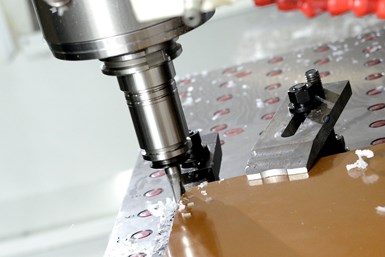
Machining plastics presents challenges in terms of tooling, workholding and chip (and dust) management. (Photo credits: K&E Plastics.)
While there are advantages to being a niche CNC machine shop, there can be distinctive challenges as well. K&E Plastics in Bennington, Vermont, is a case in point.
As the contract shop’s name implies, it focuses solely on machining engineering plastics — both thermoplastics and thermosets — and has done so since Peter Broderson founded K&E in 1966. His son, Eric, is now company president.
Because not too many shops specialize in machining plastics, including thermosets such as G7 and G10 filled with abrasive glass, there is less competition compared to those that machine aluminum, steel and other conventional metals. However, unfamiliarity with plastics by equipment and tooling vendors has meant K&E has sometimes been left to its own devices to come up with strategies for effectively machining those materials.
I learned about some of those challenges when I visited K&E in 2013 to write my first story about the shop. The need for dust collection. The difficulties fixturing plastics. The tooling issues that come with machining glass-filled thermosets. The list goes on…
Although I wasn’t able to physically revisit K&E for this story, I do appreciate reconnecting and hearing about what new technology and processes the shop has added to become more capable and effective at machining plastics. This includes looking at tooling and workholding differently, and adding its first Swiss-type lathe to achieve tighter tolerances and faster production of complex parts made of thermoplastics such as polyetheretherketone (PEEK) that previously ran on traditional gang-tool lathes. That machine also enabled the shop to bring previously outsourced work back in house.
New Opportunities, New Approaches
Initially, K&E focused on plastic parts for solely for electrical applications given the materials’ excellent electrical insulation properties (see sidebar below). When Broderson took over running the business from his father 27 years ago, he sought to diversify the company by going after nonelectrical applications in the medical and aerospace industries. Today, it is also pursuing opportunities in new energy technologies, such as electric vehicles, fuel cells and energy storage. The shop is certified to ISO 9001:2015, has International Traffic in Arms Regulations (ITAR) registration and is certified as part of the Joint Certification Program (JCP), enabling it to win secretive defense work. It is also holds certification with the Historically Underutilized Business Zones (HUBZone) program that helps small businesses in urban and rural communities gain preferential access to federal procurement opportunities.
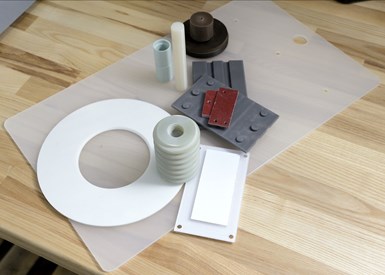
K&E machines only plastics (including thermoplastics and thermosets) for industries such as electrical, aerospace and medical. It also sees opportunities in new energy applications, such as fuel cells, electric vehicles and energy storage.
The shop’s 30,000-square-foot facility includes a range of CNC routers, VMCs and lathes — 28 in all. The majority of these are Haas Automation models. The Swiss-type lathe it purchased in 2018 is a Tsugami S205 model (more on that later). Depending on the material, these might machine parts using coolant or dry with the assistance of cold-air guns to cool cutting operations and help break chips.
Coolants are sometimes used for non-filled thermoplastics. Oil-based coolants can’t be used because they often degrade the plastic. Instead, K&E uses water-based coolants such as Trim Microsol 585XT from Master Fluid Solutions. This is said to be a high-lubricity, semisynthetic, microemulsion coolant offering extended sump life and better foam control versus previous generation semisynthetics.

K&E’s shop is distinctive in that it has ducting connecting equipment that machines plastics dry to one of two central dust collection systems.
However, many thermosets are machined dry. These materials are often filled with glass or other abrasive materials that create dust when machined. Effective dust collection is imperative to maintain a clean work environment and extend machine tool life. In fact, the ductwork used for dust collection is what gives the shop a distinct look.
Ducting is routed to the workzone of each piece of equipment that machines plastic parts dry. The shop has recently added its second 18,000-cfm dust collection system, which enables it to add as many as 12 more machining centers to machine parts dry.

The shop recently installed its second 18,000-cfm dust collection system, which enables it to add as many as 12 more machining centers to machine plastics dry.
Heat is the big issue when machining any plastic. Material burning is possible when tools are run too fast. Plus, without effective chip evacuation, machined material can re-weld back to the workpiece. Tool flute geometry plays a key role in getting chips out and away from the workpiece, as do cold-air jets. However, thermoset laminates such as G7 and G10 are also prone to delamination, depending on the bond strength of the resin and how the parts are machined.
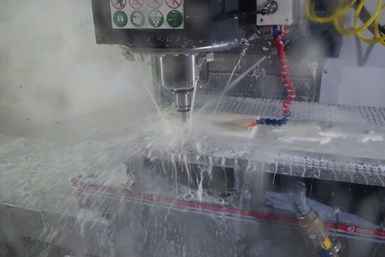
Thermoplastics are commonly machined using water-based coolants. Petroleum-based coolants can degrade the plastic material.
The shop has recently started to use cutting tools from Datron Dynamics. One example is a 6-mm diameter, polished, single-flute carbide end mill. According to the company, a multistage grinding process delivers sharp, polished edges for burr-free machining, reducing or eliminating the need to hand finish parts.
Another is carbide end mills with amorphous diamond coating for composites from Harvey Tool. These are said to be well-suited for roughing and semifinishing composite materials with high fiber or fill concentration, such as G10 and FR4, due to optimized geometry with chipbreakers that efficiently shears fibers and shortens chips for improved chip removal.
In addition, K&E now uses gun drills from Sterling when required to repeatedly produce accurate, deep holes with quality surface finishes.
The shop is also starting to standardize on the PowRgrip toolholding system from Rego-Fix for its machining centers. Reason being is that conventional toolholder systems led to runout of as much 0.002 inch, which was not acceptable for part features having very tight tolerances. “Now we’re at 4 tenths runout,” Broderson says, “giving us better surface finishes and less tool wear, while achieving requisite machining tolerances.”
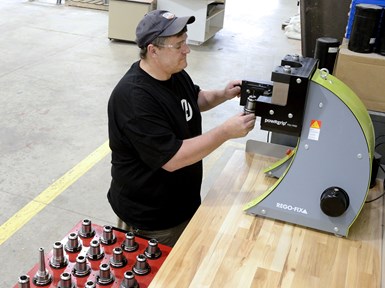
The shop has begun standardizing on toolholding systems in which a hydraulic press inserts or removes collets from the holders. Each collet has a shallow, self-locking taper and is pressed into the toolholder using 9 tons of force. Broderson says these holders offer better runout and rigidity compared to traditional models.
This system consists of precision, collet-style toolholders and a benchtop hydraulic press used to insert or remove collets from the holders. The collet has a shallow, self-locking taper and is pressed into the toolholder using 9 tons of force. It also has a square shoulder that contacts the toolholder when pressed in. This positive stop design enables the use of a built-in backup screw to accurately set tool length. These toolholders feature high clamping forces and vibration damping, and total indicator runout (TIR) of ≤ 3 microns at a length to diameter ratio of 3:1. Rego-Fix says this toolholding system also enables faster, safer tool changes than shrink-fit systems. Assembly of a new tool is said to take less than 10 seconds. “Our shop has approximately 800 of these toolholders at the moment, but we continue to add more,” Broderson says.
For workholding, some machines use vacuum chucks to speed changeovers and enable tools to access five sides of a part. Similarly, K&E has started using common foundation plates topped with Chick vises. Broderson says that because the Chick vises offer better positioning repeatability and plates install in a common location, probing during setups isn’t required versus when the shop simply bolted vises to machine tables. The shop also saves and stores vise jaws for use when jobs repeat.
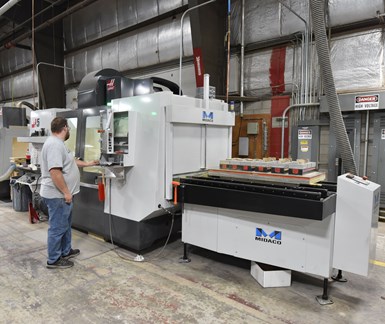
To increase spindle uptime for this VMC, K&E added a pallet-changing system so jobs can be set up offline while another is still being completed in the machine. It has done the same for two other VMCs.
To maximize spindle uptime for three of its VMCs, K&E added a Midaco pallet changer to each. This enables each machine to continue running a job while new material is fixtured to the pallet outside the machine. Once a job is completed, its pallet shuttles out and a new one with the next job fixtured shuttles in.
Why Add a Swiss-Type?
Broderson says that before adding the S205 a couple years ago, K&E had been farming out work to screw machine shops for select jobs. Over time, the amount of that outsourced work continued to increase. In addition, scrap rates or rejects for tight-toleranced jobs that ran on some of its gang-tool lathes were sometimes higher than it would like. The shop determined that a Swiss-type with signature guide bushing design and multifunction capability would deliver the requisite accuracies and enable the shop to keep that work in house.
The Tsugami S205 with 20-mm bar diameter capacity and Edge Technologies Minuteman 320 SE bar feeder was purchased through the Tsugami/REM Sales distributor, The Robert E. Morris Company. John Ricardi, company account manager, says the machine included a 1,000-psi coolant delivery system (primarily for chip control) as well as a mist collection unit, chip conveyor, special chute for receiving long parts out of the subspindle and convertible/chucker conversion capability.
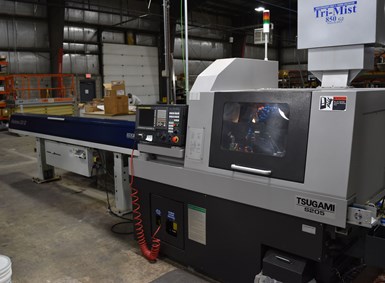
The bar feeder accommodating 10-foot-long bars enables the shop’s first Swiss-type to run unattended for longer stretches of time than the bar feeders on the gang-type lathes that run 4-foot-long bars.
Perhaps the biggest selling point for this machine is that it is designed to run with water-based coolant so as not to degrade the plastic workpieces as oil-based coolant would. Ricardi says positive air pressure for tooling attachments and spindles prevent coolant from entering bearings and washing out their lubricating oil. In addition, water-based lubrication is used in the bar feeder channel sets as well.
The Swiss-type is used for parts that require very tight tolerances. Broderson says tool pressure can cause tapers to form when running plastic parts on conventional lathes. The Swiss-type’s signature guide bushing provides the support at the cut to eliminate this problem. In addition, the machine repeats very well, he says. Once a process is dialed in, there’s no more cut, measure and repeat process. Plus, the bar feeder has the capacity to run 12-foot-long bars. K&E commonly runs 10-foot-long bars, which enables longer stretches of unattended machining compared to conventional lathes with four-foot bar feeders. For material such as PEEK, it typically orders barstock ground to +0.002” / -0”.
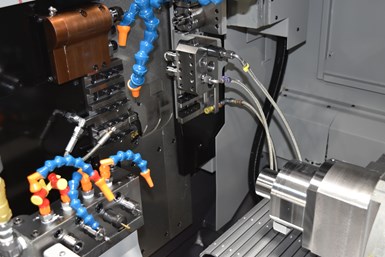
The Swiss-type lathe, which runs using water-based coolant, is said to achieve tighter tolerances and improved production for thermoplastic parts the shop previously ran on traditional gang-tool CNC lathes. The machine also enabled the shop to bring previously outsourced work back in house.
That said, the shop can remove the guide bushing and operate the machine as a conventional chucker lathe, running a job with the same machining approach as a standard lathe.
Broderson says one of the biggest learning curves was determining how much pressure to use on the high-volume coolant pump to remove chips and flood the part without changing the dimensions of the part being machined. If the pressure is too high, the stream of coolant can change the dimension of plastic parts. The shop also encountered twisting of some barstock material because the machine’s spindle ramped up to speed so quickly. The fix for that was ramping up to speed more slowly. Another challenge was learning which features on the part could be machined and when those should be sequenced.
Material Issues
One overall challenge Broderson says his shop has recently been facing is plastic material variability. Although he tries to purchase from U.S.-based suppliers, even some of those sell material produced overseas. “We have to be very specific when ordering,” he says.
In one example, the shop ordered FR4 material for a job, dialing in its machining process for that batch of material. It then ordered another batch when the job returned. However, even though that second batch met the same NEMA classification for electrical enclosures, variation with the resin and glass filler was sufficient enough that the cut data and tools used in the previous FR4 batch weren’t compatible with the new batch. “Holding two thou in a material such as this is hard enough, but variance between batches makes it even harder.”
Related Content
Software Controls Chip Breaking in Thread Turning Operations
This cutting tool manufacturer has developed a software module for chip control of thread turning operations in virtually any CNC lathe, even for older machines, using specific tooling and software.
Read MoreVideo Tech Brief: Anatomy of a Robust, High-Production Swiss-Type Lathe
This Swiss-type is equipped with a total of 52 tools, including a 40-tool magazine, 10 tools on the back tool post, and an optional 2 tools on the deep hole drill holder.
Read MoreShop Optimizes its Swiss-Turning Flexibility
Paramount Machine uses various Swiss-type lathes, some with a B axis, to produce parts more effectively than it did on conventional chucker lathes. Today, nearly every job under 1.5 inches in diameter runs across those machines even if the batch size is a mere 5 pieces.
Read MoreSwiss Rejuvenation Doubles Shop Productivity
As he progressed to CNC Swiss lead and later to his current position as CNC Swiss production supervisor, Darrin Baker helped the Swiss department at Liberty Precision double its productivity, according to his nominator.
Read MoreRead Next
Precision Machining Technology Moving Shops Forward
New equipment and software continue to be developed to support the needs of production machine shops like yours. Here’s a sample of technology now on the market that can help you grow your operation and become more efficient.
Read MoreSwiss-Types Offer Advantages Beyond Watchmaking
CNC sliding headstock lathes are becoming more popular among traditional machine shops for their multitasking capabilities, some offering B-axis milling spindles.
Read MoreSwiss Shop Turns Precision into Profit
The quality demands for micro-machined parts are swiftly increasing. Shops must be ready and willing to adjust their machining strategies to fit the need.
Read More








.jpg;maxWidth=300;quality=90)







